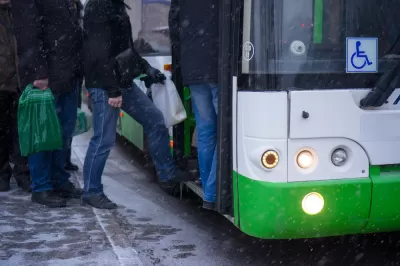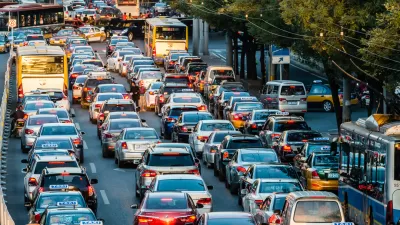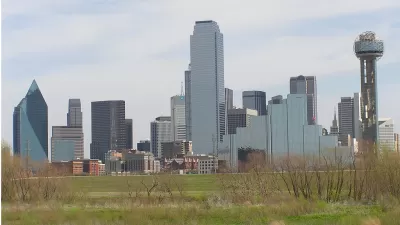Despite the decline in gas prices, cars are still a luxury for many low-income Americans, and low-income zip codes still tend to have low car ownership rates.

A couple of weeks ago, I read a story in the Philadelphia Inquirer: "For workers in Philadelphia’s poor neighborhoods, car ownership often a necessity and a privilege." The article, and the Twitter buzz about the article, discussed low income workers who were unable to reach jobs without cars, and claimed low-income workers can afford used cars. Certainly, this story has a grain of truth: not every job is accessible to people without cars, and there are many low-income workers who purchase them—perhaps even more so in recent years as gas prices have declined. Does this mean that there are no more carless poor, or that we don’t need to have buses and trains to accommodate them?
If that were the case, low-income neighborhoods would have car ownership rates comparable to those of other neighborhoods. But low-income neighborhoods usually do nor have car ownership rates comparable to other neighborhoods. In one of North Philadelphia’s poorest zip codes (West Philadelphia’s 19104, which has a 46 percent poverty rate), 57 percent of households do not own a car—as opposed to 31 percent for the city as a whole, and 26 percent for a richer zip code next door (19130, the Art Museum area). Similarly, in zip 19121, 51 percent do not own a car. And we don't know what the car-owning majority had to give up to afford their cars.
These areas are relatively close to Philadelphia’s flourishing downtown. What about poor areas further out? Suburbanites generally own cars—but even so, low-income suburbanites are far less likely to own cars than middle-class suburbanites. For example, Chester, Pennsylvania is a low-income suburb where only 31 percent of households lack a car. But this percentage is still far higher than the percentage for most Philadelphia suburbs. In Chester County, only 4 percent of households are carless, and in closer-in Delaware County, only 10 percent. Similarly, at the outer edges of the city of Philadelphia itself, low-income areas have more car owners than the poor areas closest to downtown, but fewer than nearby middle-class areas. For example, zip code 19120 at the city's edge has a 31 percent poverty rate and a 27 percent carless-household rate—much lower than that of close-in poor areas, but still far higher than affluent areas that are also at the edge of the city, such as zip code 19118 (11 percent carless) or 19128 (8 percent).
Of course, Philadelphia is more dense, and has better public transit, than most cities. What about car-dependent cities like Atlanta? Zip code 30314 contains Vine City, one of Atlanta’s poorest neighborhoods—and there 31 percent of households do not have a car, about the same as in Chester. Similarly, in downtown zip code 30303 (which has a 56 percent poverty rate) 34 percent of households have no car. By contrast, in 30309 (an affluent midtown zip code), only 8 percent of households lack cars—lower than the citywide average of 16 percent.
Similarly, in the poorest zip code of Jacksonville, Florida (32202) 38 percent of households had no cars—far below the citywide average of 8 percent, and also far below that of affluent intown zip codes such as 32207 (which includes the San Marco neighborhood just a mile from downtown, and has an 11 percent carless rate).
In sum, it is clearly the case that poverty-packed neighborhoods still have car ownership rates far below that of nearby middle- and upper-class areas. What, if anything, should be done about this, I leave for others to discuss (at least for the time being).

Alabama: Trump Terminates Settlements for Black Communities Harmed By Raw Sewage
Trump deemed the landmark civil rights agreement “illegal DEI and environmental justice policy.”

Study: Maui’s Plan to Convert Vacation Rentals to Long-Term Housing Could Cause Nearly $1 Billion Economic Loss
The plan would reduce visitor accommodation by 25% resulting in 1,900 jobs lost.

Why Should We Subsidize Public Transportation?
Many public transit agencies face financial stress due to rising costs, declining fare revenue, and declining subsidies. Transit advocates must provide a strong business case for increasing public transit funding.

Wind Energy on the Rise Despite Federal Policy Reversal
The Trump administration is revoking federal support for renewable energy, but demand for new projects continues unabated.

Passengers Flock to Caltrain After Electrification
The new electric trains are running faster and more reliably, leading to strong ridership growth on the Bay Area rail system.

Texas Churches Rally Behind ‘Yes in God’s Back Yard’ Legislation
Religious leaders want the state to reduce zoning regulations to streamline leasing church-owned land to housing developers.
Urban Design for Planners 1: Software Tools
This six-course series explores essential urban design concepts using open source software and equips planners with the tools they need to participate fully in the urban design process.
Planning for Universal Design
Learn the tools for implementing Universal Design in planning regulations.
Caltrans
Smith Gee Studio
Institute for Housing and Urban Development Studies (IHS)
City of Grandview
Harvard GSD Executive Education
Toledo-Lucas County Plan Commissions
Salt Lake City
NYU Wagner Graduate School of Public Service






























